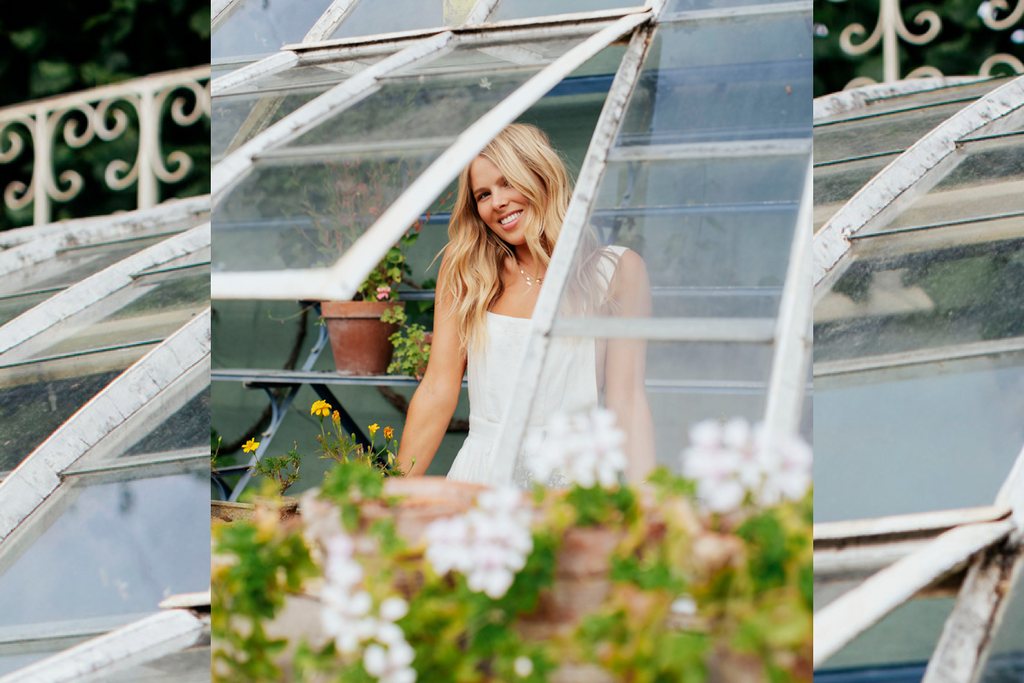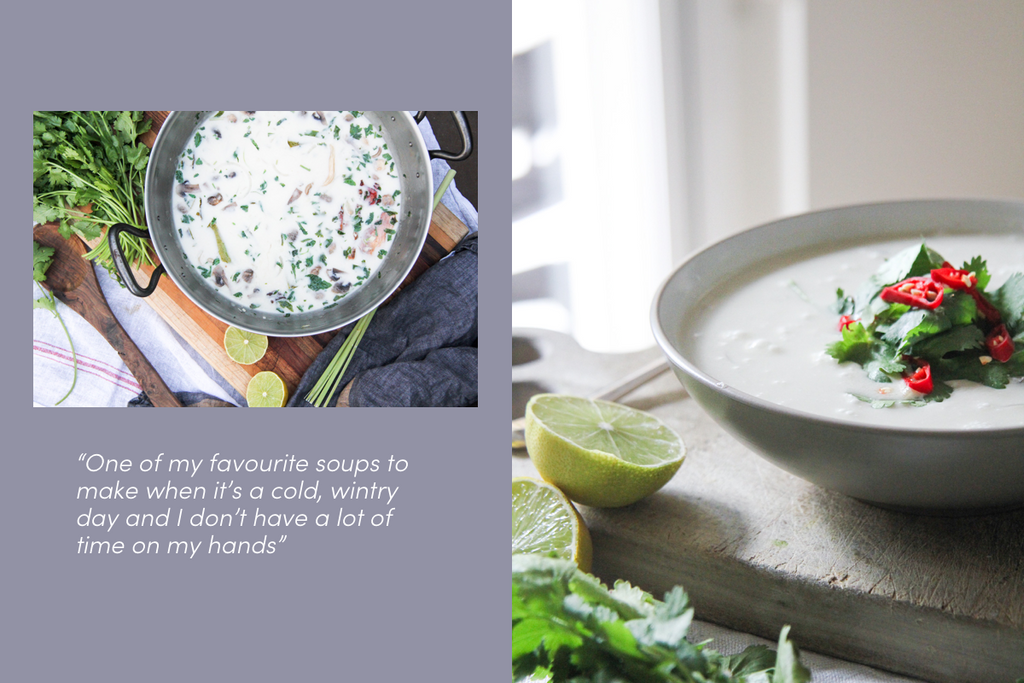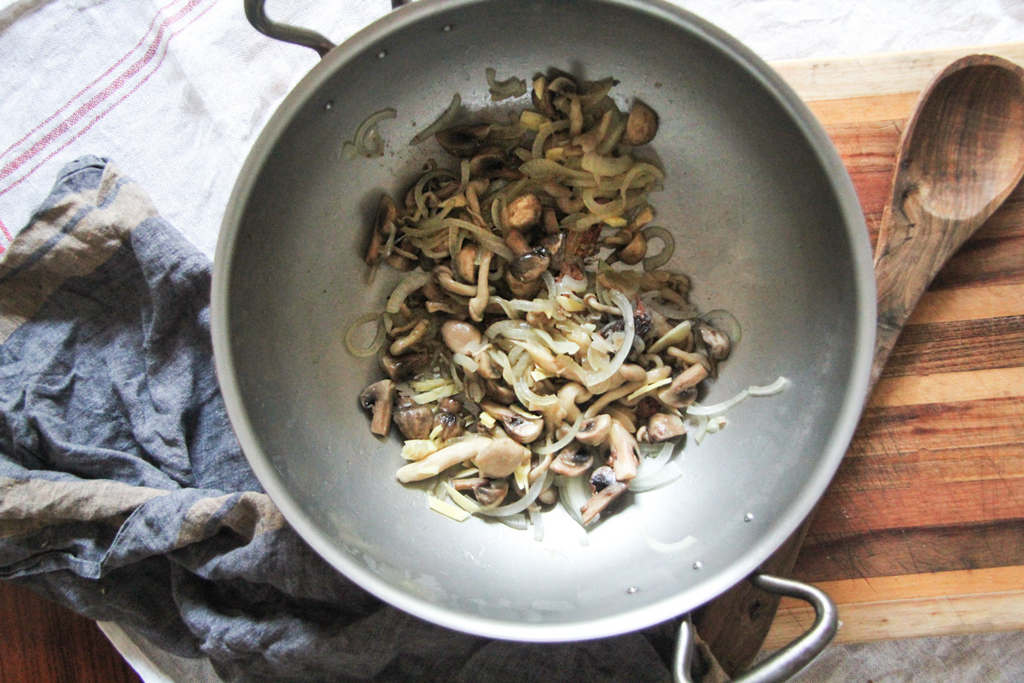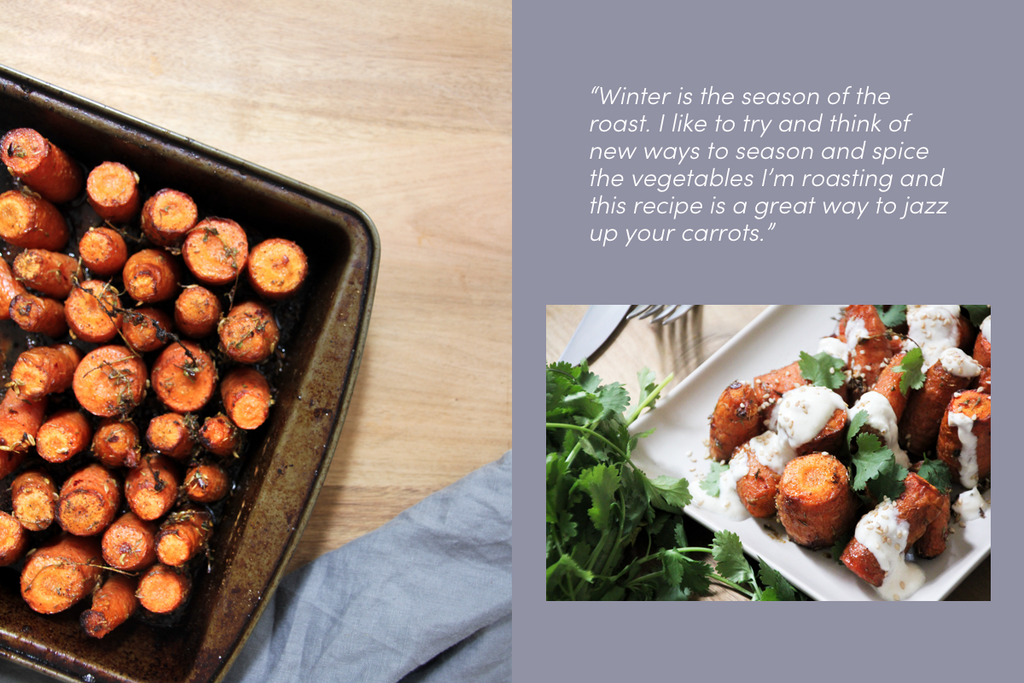
There are plenty of things not to love about winter: it gets dark too early. It’s too cold. It gets harder and harder to get out of bed. Grumble, grumble, moan, moan.
But then again, there are many things we all love about the colder months, too. Chunky knits. Cosy nights in. And best of all – good ol’ fashioned comfort food.
To help us with some meal inspo to get through the colder months, we caught up with food and travel blogger Steph from By Babette. From a Thai Coconut and Galangal Soup to Roast Maple Spiced Carrots with Tahini Dressing, Steph’s mouth-watering, plant-based recipes will warm you up in no time. They will also keep you fit and healthy in the winter months.
So, whether you’re considering a plant-based diet or simply want some delicious vegan recipes to give dairy-free living a whirl, look no further. But before we get to that, we thought we’d tell you a bit about what By Babette is.
What is By Babette?

Photography by Kit Lee.
By Babette was created by Steph, a 29-year-old Melbourne-born, ex-Londoner who adores both creating and consuming food (if you’re wondering, ‘Babette’ is Steph’s middle name). In her recipes, Steph focuses mostly on plant-based, often vegetarian or vegan and sometimes pescatarian food.
Steph endeavours to share meal ideas on her travel and recipe blog that nourish and strengthen the body using fresh seasonal fruit and vegetables, whole grains and avoiding overly-processed foods. That said, Steph is also partial to some indulgences, so of course, shares the occasional zucchini cake or coconut brownie recipe.
Over to you, Steph!
Hearty recipes for the colder months
As winter slowly encroaches and we say goodbye to the last of the balmy weather, it’s also time to bid farewell to all the beautiful fruit and vegetables that come with the warmer months. Whilst I love all the summer produce, I welcome the winter goodies with open arms. It signals that it’s time to switch up some of my regular go-to recipes and look to some cosy, warming winter favourites.
The change of seasons is the perfect reminder not to be complacent with your cooking and to try new recipes and ingredients. If you like to frequent farmer’s markets or get organic produce delivered (this is the dream for anyone who is time poor but wants to eat organic and seasonal food), you will notice a clear shift in what’s available.
Winter heralds root vegetables, pumpkin and squash, dark leafy greens, Asian greens, fennel, potatoes, onions, garlic, ginger cabbage and other cruciferous vegetables, broccoli, beetroot, carrots, mushrooms and parsnips. All perfect for comfort food recipes.
There is perhaps less available in the fruit category (however, still a lot to get excited about!) with the heroes of winter being navel oranges, pears, apples, pomegranates, lemons, rhubarb, grapefruit, mandarins and kiwi fruit. It’s time to make crumbles and pies, nutrient-packed juices and warming spicy stewed fruit.
I’ve never really been a soup person, but as you can see, the vegetables that are available in winter clearly lend themselves to soup. Creamy leek and potato, spiced carrot and pumpkin, minestrone (an excellent soup to make any time of year as you can use almost anything!), and variations on the ever-popular Vietnamese pho are lovely, but there is one soup that is not widely made by Australians, and is incredibly easy and wonderfully delicious.
Tom Kha – Thai Coconut & Galangal Soup

‘Tom Kha’ in Thai translates to galangal soup. This is one of my favourite soups to make when it’s a cold, wintry day and I don’t have a lot of time on my hands. For anyone unfamiliar with galangal, it’s from the ginger family and has a similarly-delicious fragrant, herbal flavour composition. It's also very similar to ginger physically and incidentally has similar stomach-soothing properties.
Galangal root is primarily used in Asian cooking, being most often associated with Indonesian, Thai, Malaysian and Indian cuisine. If you can buy or grow fresh galangal – that’s wonderful as you’ll be able to make a myriad of delicious soups and curries. For anyone who struggles to get fresh galangal, don’t fret, you can get it dried or minced in a jar from any Asian grocer and sometimes the supermarket.
The variations of Tom Kha soup don’t vary enormously, this vegan recipe is how I like to eat it, though you will come across many recipes with chicken which is absolutely not necessary.
I like to use a mix of coconut milk and vegetable stock, however, if you want a creamier soup, go heavier on the coconut milk and vice versa. The quantities are very forgiving, so don’t worry too much about being exact.
The vegetables I favour are mixed mushrooms and Asian greens (winter favourites!) like pak choi, Kailaan (Chinese broccoli), wombok (Chinese cabbage) and tatsoi.
A little tip on the chillies: before you throw them in, cut the end off and touch it on your tongue to assess the spiciness, then add as much as you think you’d like. Be aware that the seeds are the spiciest part of the chilli, so keep these out if your tolerance is low. You can always add more but reducing the heat is not really possible once it has infused the soup!

Ingredients
-
1 tbsp organic coconut oil
-
1 medium white or brown onion, finely sliced
-
2 cups of mushrooms (shitake, button or cremini)
-
1 knob of galangal, peeled and finely sliced
-
1 knob of ginger, peeled and finely sliced
-
1 stalk of lemongrass, finely chopped
-
3-5 Thai chillies
-
600ml organic coconut milk
-
2 cups organic vegetable stock
-
8 kaffir lime leaves
- ½ teaspoon salt (to taste)
-
2 limes juiced
-
½ tbsp brown sugar
-
Small bunch of coriander
-
Small bunch of Thai basil
-
2 cups of vegetables (for example, bok choy, pak choi, cabbage, broccolini, capsicum, bean shoots etc.)
Directions
-
Wash and quarter your mushrooms (you want them to be bite size).
- In a non-stick pan, heat the coconut oil over medium heat. Add the onions and mushrooms to sweat a little, until the onions are translucent. Add the galangal, ginger, lemongrass and chilli, stir for 1 minute.
-
Add the coconut milk, vegetable stock, kaffir lime leaves, salt, lime juice and simmer gently for 10-15 minutes, letting the broth infuse.
-
Add the coriander, basil leaves, along with the vegetables you want in the soup – cook for 3 more minutes.
- Taste and season accordingly. Top with fresh herbs.
Another of my favourite vegan soup recipes is my Spiced Squash & Veggie Laksa.
Roast Maple Spiced Carrots with Tahini Dressing

As I mentioned, winter is the season of the roast. I like to try and think of new ways to season and spice the vegetables I’m roasting and this recipe is a great way to jazz up your carrots.
Roasting honey and carrots together is a popular one and something you’ll find in many cookbooks. To adapt that classic combination to be vegan-friendly, I use maple syrup instead of honey (though either will work). I think the sweet, syrupy flavour goes so well with carrots as they have a naturally-sweet profile, and therefore enhances their natural flavour.
This recipe is very much Middle Eastern-inspired with lots of spices added to the roasting marinade and tahini dressing.
I have baked the carrots upright here, but you don’t need to do this. They will taste the same if you just throw them all in haphazardly.
Ingredients
-
1 teaspoon of chilli flakes
- 1 teaspoon of fennel seeds
- 1 teaspoon of ground coriander
- 1 teaspoon of ground cumin
- A small handful of fresh thyme sprigs
- 2 tablespoons maple syrup
- 3 tablespoons of extra virgin olive oil
- Approximately 1kg carrots, chopped into 3cm pieces (roughly)
- 1 tsp each of salt and pepper (roughly)
- 1 heaped tablespoon of tahini
- 1 small garlic clove, minced or grated
- ½ cup of plain coconut or almond yoghurt
- ½ juice of lemon
- To garnish: coriander leaves and toasted sesame seeds
Method
-
Preheat oven to 220 C
- Combine the chilli flakes, fennel seeds, coriander, cumin, thyme, maple syrup, olive oil, salt and pepper in a large bowl. Add the chopped carrots and toss until thoroughly coated with the marinade.
- Bake in oven for 50-60 minutes, turning once. Cook for longer if you want really soft carrots – I like them a little firm.
- In the meantime, to make the tahini dressing, combine the tahini, garlic, yoghurt and lemon juice in a bowl and mix well to combine. Season to taste. This can be made ahead of time and kept in the fridge for 2-3 days.
- Once the carrots are cooked, let them cook a little to room temperature, spoon the yoghurt dressing on top, and sprinkle with fresh coriander and sesame seeds.
For more recipes follow By Babette’s website and on Instagram @bybabette.
You may also like

Lifestyle
What To Gift a Newborn Baby
We’re a big fan of gifts that are both functional and comfy. Our brand was built with practicality, ease, function and comfort in mind. It was a collective passion, drive and demand for a simpler wardrobe made from sustainable fabrics that supported the everyday lifestyle that drives our brand identity. So when it comes to gifts for a newborn - what better gift than something that is good for them and the planet. A baby’s first wardrobe starts here. Boody Baby is an adorable collection of practical, Australian made baby clothing essentials created from organic bamboo. Perfect for play and sleep, the stretchy fit of our bamboo baby wear clothes is super soft on your bub’s delicate skin. Discover warm baby beanies, booties, baby blankets, bodysuits and more. All designed with zero waste and with your baby and the planet in mind. Natural fabrics - like certified organically grown bamboo are best for a newborn’s delicate skin, as they are breathable, soft and thermoregulating. If we think about baby clothes , including singlets, bodysuits and mittens - choosing natural fibres is the gentlest choice and the most functional gift of them all. To make gift-giving for newborns easier, we have compiled a list of what to buy. Okay, what size do I choose? On average, babies are born between 3-4kg, which generally means a size 0000. You can choose something for them to wear now (newborn) or something for them to grow into. See our size guide for help. Baby Sleeveless Bodysuit Introducing the Baby Sleeveless Bodysuit, gentle on their delicate skin and kind to the planet. Created for warmer days and nights, the Baby Sleeveless Bodysuit is designed with no sleeves and features snap buttons at the crotch for easy dressing and undressing. Finished with our signature trim and overlocked hem, our naturally breathable baby bodysuit is easy to wear and wash. This bodysuit is a staple in our collection of organic baby clothes. - Snap buttons at crotch for easy dressing and undressing - Signature trim - Round neckline Baby Long Sleeve Top Introducing the Baby Long Sleeve Top, gentle on their delicate skin and kind to the planet. Our Baby Long Sleeve Top will keep your little one protected and comfortable while busy playing and exploring. Featuring a Round neckline, snap buttons on the shoulder for easy dressing and undressing and overlocked hems, our Baby Long Sleeve Top is easy to wear and wash. Mix and match this baby top with our assorted bottoms including our Baby Pull-On Pants and Baby Pull-On Shorts. - Round neckline - Snap buttons on the shoulder for easy dressing and undressing - Overlocked hems Baby Pull-on Pants Introducing the Baby Pull-on Pants, gentle on their delicate skin and kind to the planet. Our Baby Pull-on Pants make getting dressed in the mornings easier with an elasticised, wide waistband for comfort and drawstrings at the waist. Our Baby Pull-on Pants pull on with ease and are designed to accommodate bulky nappies. Mix and match these baby pants with our assorted tops including our Baby Long Sleeve Top and our Baby T-Shirt. - Elasticised, wide waistband for comfort - Drawstrings at waist - Designed to accommodate bulky nappies Baby Socks - 3 Pack Introducing our Baby Socks, gentle on their delicate skin and kind to the planet. Our Baby Socks are perfect for every day. Breathable and soft, they feature an elasticised ribbed top for comfort all day long. With a non-slip sole, our bamboo socks for babies are crafted with a little stretch for the perfect fit. Discover our Baby Socks - 3 packs, including 2 plain pairs, 1 striped pair. - Each pack contains three pairs of socks: 2 plain pairs, 1 striped pair - Soft, elasticised ribbed top for comfort all day long - Non-slip sole for safety Stretch Jersey Wrap for Babies Introducing our Stretch Jersey Wrap for Babies, gentle on their delicate skin and kind to the planet. Our Stretch Jersey Wrap for Babies is super soft and super stretchy for easy swaddling. Simply double it over, wrap, pull firm and tuck the ends in well to keep your little one comfortable. Our bamboo baby wrap is the most gentle touch on a little one's sensitive skin - Size: 100cm x 100cm / 39" x 39" in - Contrast edging all around - Super stretchy fabric for easy swaddling Mindful Gifting Our bamboo, Australian made baby clothes and accessories are packaged in a 100% recyclable paper box printed with vegetable-based inks. For the ultimate packaging - wrapped in a cloth following the furoshiki technique. Discover our Baby bamboo clothes collection today. Looking to see our collection worn on very adorable little ones? Follow @boodybabyau

Lifestyle
The Ultimate Beginner's Guide to Zero-Waste Living
So, you have heard the term zero-waste and you’re interested to learn more. A zero-waste lifestyle is about being mindful and considered in your everyday actions. A zero-waste lifestyle is a journey and the notion of avoiding, reducing and eliminating waste from your home and habits will not happen in an instant. The idea of waste-free living is about making considered decisions that are simple everyday swaps. While this lifestyle has a real, community-wide impact, it simply starts with you and your everyday actions.

Lifestyle
Boody x Charlie Evans
Last week, in celebration of our New Nude collection, we hosted a 'nude' art class with @_artbycharlie. Charlie led the class, discussing abstract figurative techniques and started with a drawing exercise, focusing on the lines of the body, shapes, movement, negative and positive space, placing and composition. Our models were in the nude - Boody nudes. They each showcased the new colours and were the drawing focus of the class. Depending on your skin tone, everyone's version of nude is different. We believe that every line, fold, curve, shape, and colour that makes you you is something to celebrate. Our class was inspired by nude being a state of being, not a colour. Discover our collaboration below with images of the day. Shop nudes.






















